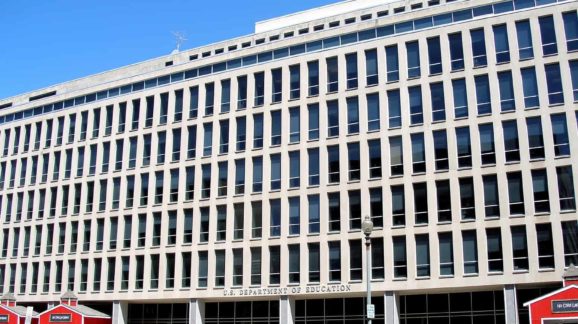Department of Education Limits Federal Employee Union Subsidy

 Department of Education Secretary Betsy DeVos deserves a round of applause. Most federal agencies, even in Republican administrations, agree to collective bargaining agreements that heavily subsidize federal employee unions’ cost of representation. Instead, DeVos diverged from past practices and scored a win for taxpayers.
Department of Education Secretary Betsy DeVos deserves a round of applause. Most federal agencies, even in Republican administrations, agree to collective bargaining agreements that heavily subsidize federal employee unions’ cost of representation. Instead, DeVos diverged from past practices and scored a win for taxpayers.
Last week, the Department of Education ended contract negotiations with the American Federation of Government Employees and implemented a new contract. Department spokesperson Liz Hill stated “The union spent more than a year dragging its feet on ground rules negotiations without reaching any agreement and then failed to respond in a timely manner to negotiate over the contract proposed by the department… This contract complies with all statutory requirements and maintains union members’ rights under the Civil Service Protections Act and the Federal Labor Relations Act.”
Unsurprisingly, the AFGE filed an unfair labor practice charge with Federal Labor Relations Authority, which asks for the Department to comply with the past collective bargaining agreement and return to the bargaining table.
More importantly than the back and forth between the Department and AFGE is the fiscally responsible elements included in the collective bargaining agreement.
According to media reports, union official time is curtailed in the new collective bargaining agreement. This practice allows federal employees perform union activities on the taxpayers’ dime. Official time represents a costly, annual subsidy to federal employee unions.
The new agreement cuts the “council president, national shop steward and Local 2607 president” official time use from 100 percent with pay to 50 percent leave without pay for union business. Further, instead of letting 75 union stewards use “reasonable amounts” of official time during the year, the Department will provide AFGE with a bank of 4,927 hours of leave without pay per year for union official to represent employees.
As part of many official time packages, union officials also receive government office space and supplies like computers, telephones, and more. The new contract also limits these giveaways.
Cutting the amount of official time represents a significant cost savings. In FY 2014, the Office of Personnel Management (OPM) estimated that Department of Education official time cost $429,306. But the Government Accountability Office has investigated the OPM’s accounting standards and found that it underestimates the true cost of official time. In a FedSmith.com article, retired agency labor and employee relations director Bob Gilson estimates the cost savings from curtailing official time is in the ballpark of $1.5 million.
Beyond beyond a fiscally responsible move, limiting official time means more Department employees will perform the civic duties they were hired to do instead of union business.
Another problem associated with official time, and one reason why cost estimates are inaccurate and low, is it is normally not properly tracked and recorded. To remedy this, the Department of Education contract imposes “new disciplinary process if union officers fail to record official time promptly and accurately. This process was absent from the previous agreement.”
The costs of official time are even more outrageous when one looks at how many active members are actually full-fledged members of AFGE at the Department. In Gilson’s article, he notes that AFGE represents 3,900 Department of Education employees, but only had 645 members according to reports filed with the Department of Labor. This means the vast majority of Department employees do not feel it is worth paying dues to AFGE for its representation. If most employees do not think union representation is worth their hard earned money, why is it incumbent on taxpayers to subsidize union representation?
As I’ve noted for years, Congress should eliminate official time because it is a wasteful subsidy to federal employee unions that serves the interests of unions and their members, not the public. But it is far easier for federal agencies to take a hardline stance in collective bargaining negotiations and restrict the amount of official time granted to federal employee unions. Hopefully, the Department of Education’s fiscally responsible collective bargaining agreement is replicated by other agencies.